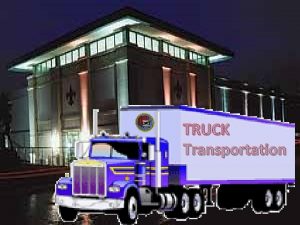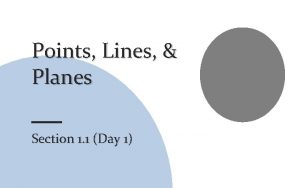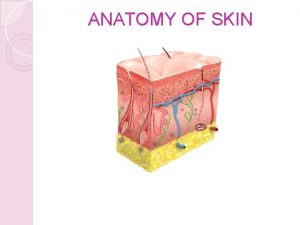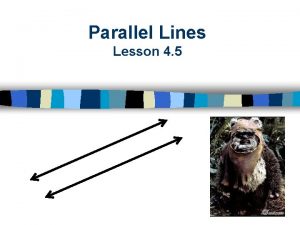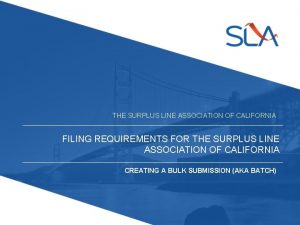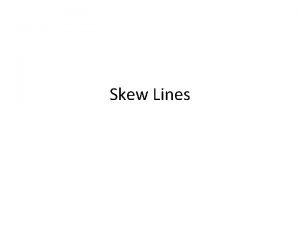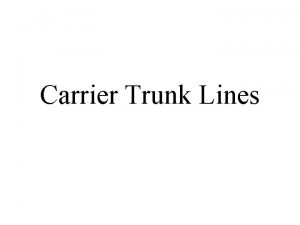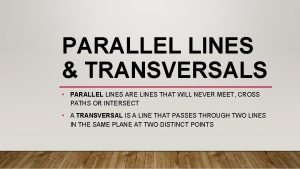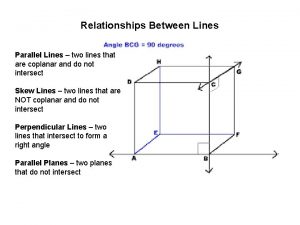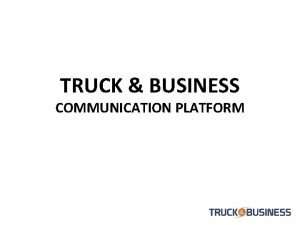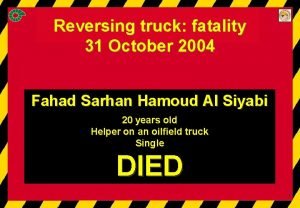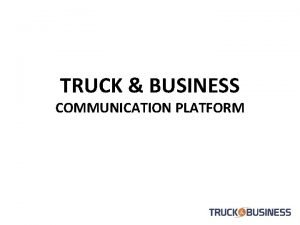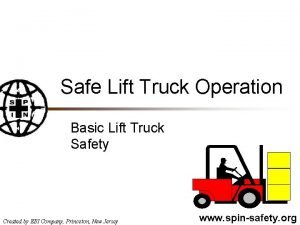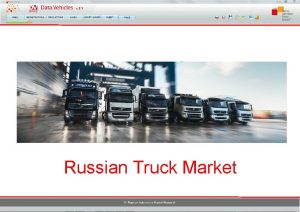TRUCK Transportation 1 List the major truck lines



















































- Slides: 51

TRUCK Transportation


1. List the major truck lines serving your town.

Schneider Yellow JB Hunt Roadway Champion UPS


2. Do the following: a. Describe the role of truck transportation within commerce (the movement of goods, funds, and information). b. Describe how trucks fit into a company's supply chain. This could be a manufacturer, importer, wholesaler, or retailer. c. On paper, map out how goods that are manufactured overseas are transported to a retailer in this country.

a. Describe the role of truck transportation within commerce (the movement of goods, funds, and information). United States distribution and supply chain network depends on the trucking industry to move 70 percent of the nation’s freight Transportation plays an important role in determining the profitability of operating both farm and nonfarm businesses in rural areas. Farms, businesses, and industries in rural areas rely on transportation services to achieve necessary production outputs and to deliver commodities and products to market. At this very moment, and around the clock, coast-to-coast, trucks are on the road hauling the essentials - everything the Nation needs such as food, books, clothing, electronics, automobiles and medical supplies. In 2006, the U. S. trucking industry hauled 70 percent of the total volume of freight transported in the United States. More than 26 million trucks of all classes, including 2. 9 million typical Class 8 trucks operated by more than 580, 000 interstate motor carriers, kept America moving. Trucking also plays an important role in trade exchanged between the United States and two of our largest trading partners, Canada and Mexico. Trucks transported 80. 7 percent of the value of trade between the United States and Mexico in 2006 and 64. 4 percent of the value of trade between the United States and Canada.

b. Describe how trucks fit into a company's supply chain. This could be a manufacturer, importer, wholesaler, or retailer. One major retailer has structured a supply chain with a 48 -hour response time on fashion products sourced in the Far East. If you buy a fashion garment from one of its stores in your local mall, the data is transmitted to a factory in the Far East. The factory keeps semi-finished "greige goods" products in stock, and that day it cuts and tailors a replacement for the one you bought. The garment is flown to the United States on an air freighter, cleared through dedicated customs, and driven through the night to the store in your local mall to replace the one you bought. “If you think of a retailer, there is the trucker who picks the items up at the factory in China and then delivers them to the port where another person consolidates the shipment for air or sea transport, ” he says. “Then there is a person to make sure the items clear customs and deconsolidate the shipment. Then there is warehousing and shipping to stores It is this complexity that allows guys like us to add value. There are time zones, currencies, financial interfaces, different transport vehicles, resulting in a horizontal list of skills and processes that cut across all of the logistics providers for any executive seeking to coordinate this aspect of his business. ”

c. On paper, map out how goods that are manufactured overseas are transported to a retailer in this country.


3. Describe the difference between the gasoline engine and the diesel engine that power trucks. List the advantages of each.

Gas Diesel Horsepower Torque 1 gallon / 125, 000 BTUs energy 1 gallon / 147, 000 BTUs energy GM 8. 1 L $850. 00 Spark Plugs – easy cold start GM 6. 6 L $4, 810 110 volt heating element

A gasoline engine runs on the Otto cycle, in which a vaporized mixture of gasoline and air is delivered to the combustion chamber, where it’s then compressed and ignited by a spark plug. In the Diesel cycle, air is compressed during the compression stroke and fuel is injected into hot, compressed air in the cylinder, spontaneously igniting the fuel. Because of this, the diesel is sometimes referred to as a compression ignition engine in contrast to a spark ignition engine. Diesel engines are also more efficient than their gasoline counterparts because more power is produced as a result of the higher compression of the air/fuel mixture. Today’s gasoline engines have compression ratios of about 10: 1 to 11: 1, while the compression ratios in diesels can be as high as 25: 1. The higher the compression ratio, the more power generated. The much higher compression ratio means diesel engines have to be heavier and more robust. This means they are more expensive to build, but the higher cost is offset by much longer lifetimes. For instance, we’ve seen Mercedes-Benz diesels with 350, 000 or more miles on the odometer running great on the original engine. Because of higher component weight and high compression ratios, diesels operate at lower rpms, producing lots of low end torque but less horsepower.


4. Visit a truck terminal and complete items 4 a through 4 e. After your visit, share what you have learned with your counselor. a. Find out what kind of maintenance program the company follows to help keep its fleet, drivers, and the roadway safe. b. Find out how dispatchers maintain communication with drivers on the road. c. Talk with a professional truck driver about safety. Learn about the truck driver's rules of the road for safe driving. List five safe-driving rules every professional truck driver must follow. d. Review the driver's log and find out what kind of information the log contains. e. Learn about important federal regulations that help ensure public safety.

a. Find out what kind of maintenance program the company follows to help keep its fleet, drivers, and the roadway safe.

b. Find out how dispatchers maintain communication with drivers on the road. Qualcomm

c. Talk with a professional truck driver about safety. Learn about the truck driver's rules of the road for safe driving. List five safe-driving rules every professional truck driver must follow. The hours of service (HOS) are regulations issued by the Federal Motor Carrier Safety Administration (FMCSA) governing the working hours of anyone operating a commercial motor vehicle (CMV) in the United States for the purpose of "interstate commerce"— moving commercial goods from one U. S. state to another. This includes truck drivers and bus drivers who operate CMVs for motor carriers (their employers). These rules limit the number of daily and weekly hours spent driving and working, and regulate the minimum amount of time drivers must spend resting between driving shifts. For intrastate commerce, the respective state's regulations apply. Stay Alert Operating a vehicle safely demands that the driver concentrate on driving. The person should be rested, calm and not under the influence of alcohol or other drugs. One of the greatest hazards of roadway driving is drowsiness or “highway hypnosis. ” Drive Defensively Plan ahead for the unexpected. Always be prepared to react to the other driver. Do not expect the other driver to do what you think he/she should do.

c. Talk with a professional truck driver about safety. Learn about the truck driver's rules of the road for safe driving. List five safe-driving rules every professional truck driver must follow. Following Distances Following a vehicle too closely is called “tailgating. ” Use the eight-second rule to determine a safe following distance. Select a fixed object on the road ahead such as a sign, tree or overpass. When the vehicle ahead of you passes the object, count “onethousand-one, one-thousand-two, etc. ” EQUIPMENT, INSPECTION, AND USE Before operating a vehicle, drivers are responsible for ensuring that all brakes, the steering mechanism, the lights and reflectors, tires, horn, windshield wipers, mirrors, coupling devices, and all emergency equipment are in good working order. SAFE LOADING At the beginning of a trip, after the initial 25 miles traveled, and, depending on which comes first, every 3 hours or 150 miles of each change of duty status cargo must be inspected to make sure it is properly distributed and secured.

d. Review the driver's log and find out what kind of information the log contains. n i riv S d rt ta P. G. g Tx op St d in riv g. M y, rra u St t ar Ok S , K y ity da C s he sa t t n r a gh fo – K frei k g r d n o w ivi oa dr unl op St op k ra ur g. M O y, n ivi dr St

e. Learn about important federal regulations that help ensure public safety. Department of Transportation's drug and alcohol testing rules include requirements for employers to submit drug and alcohol testing The FMCSA amends the Federal Motor Carrier Safety Regulations (FMCSRs) prohibiting States from issuing, renewing, transferring or upgrading a commercial driver's license (CDL) with a hazardous materials (hazmat) endorsement unless the Transportation Security Administration (TSA) has first conducted a background records check of the applicant and determined the applicant does not pose a security risk warranting denial of the hazardous materials endorsement. Federal Motor Carrier Safety Regulations require truck drivers to be at least 21 years old, have at least 20/40 vision and good hearing, and be able to read and speak English. They also must have good driving records and a commercial driver’s license, which they obtain by passing a written examination and a skills test in which they operate the type of vehicle they will be driving.


5. Do the following: a. Outline the general organization of a trucking company. Describe what each department does. b. List five positions with trucking companies and describe each one.

a. Outline the general organization of a trucking company. Describe what each department does. Experienced and reliable truck drivers Laborers, and hand freight, stock, and material movers help load and unload freight and move it around warehouses and terminals. Dispatchers coordinate the movement of freight and trucks, and provide the main communication link that informs the truck drivers of their assignments, schedules, and routes. Office and administrative support workers perform the daily recordkeeping operations for the truck transportation and warehousing industry

b. List five positions with trucking companies and describe each one. Dispatcher Sales & Service Operation Manager Diesel Mechanic Forklift Driver Class A CDL Driver


6. Name five government agencies that work closely with the trucking industry. Describe their role.

6. Name five government agencies that work closely with the trucking industry. Describe their role. Department of Motor Vehicles Federal Motor Carrier Safety Administration Public Utilities Commission U. S. Department Of Transportation US Customs DMV : requires the registration of vehicles and licensing of drivers Sets and enforces the motor carrier safety regulations PUC : regulates intrastate trucking, Intrastate trucking refers to freight shipments commencing and concluding within the state Repair and construction of highways The federal agency which oversees the entry of foreign goods into the U. S.


7. List five different kinds of trucks. Tell the service each provides.

7. List five different kinds of trucks. Tell the service each provides. 1 of 3

7. List five different kinds of trucks. Tell the service each provides. 2 of 3 Auto Haulers : Flat Bed : Hauling cars on a specially built trailers and require specific skills to load and operate Drivers haul an assortment of large bulky items, such as : tanks, steel pipes, lumber. etc… Vocational Drivers : Drive a vocational truck such as a dump truck, garbage truck, or cement mixer Household Goods : Haul personal effects for families who are moving from one home to another Container Intermodal : Drivers do all the above, except their cargo containers are lifted on or off the chassis, at special intermodal stations

7. List five different kinds of trucks. Tell the service each provides. 3 of 3 Gross Vehicle Weight Rating Class 1 Class 2 Class 3 Class 4 Class 5 Class 6 0 – 6, 000 lbs 6, 001 – 10, 000 lbs 10, 001 – 14, 000 lbs 14, 001 – 16, 000 lbs 16, 001 – 19, 500 Lbs 19. 501 – 26, 000 Lbs Light Duty Medium Duty Heavy Duty Class 7 and above require a commercial Driver License to operate Class 7 26, 001 – 33, 000 Lbs Class 8 is anything above 33, 001 Lbs GVWR Heavy Duty


8. Assume that you are going to ship by truck 500 pounds of goods (freight class 65) from your town to another town 500 miles away. Your shipment must arrive within three days. Explain in writing: a. How to prepare the shipment b. How to compare at least three carriers for time in transit and rates c. How to choose which carrier to use d. How to insure the shipment for damages

8. Assume that you are going to ship by truck 500 pounds of goods (freight class 65) from your town to another town 500 miles away. Your shipment must arrive within three days. Explain in writing: a. How to prepare the shipment

8. Assume that you are going to ship by truck 500 pounds of goods (freight class 65) from your town to another town 500 miles away. Your shipment must arrive within three days. Explain in writing: b. How to compare at least three carriers for time in transit and rates 1 of 2 WWW. INTERNETTRUCKSTOP. COM WWW. FREIGHTQUOTE. COM WWW. GETLOADED. COM WWW. WORK. COM or call each carrier - UPS / Saia / JBHUNT / Schneider / Yellow / Central / Southwestern Motor Transport

8. Assume that you are going to ship by truck 500 pounds of goods (freight class 65) from your town to another town 500 miles away. Your shipment must arrive within three days. Explain in writing: b. How to compare at least three carriers for time in transit and rates 2 of 2 WWW. FREIGHTQUOTE. COM Based on 500 lb. 500 miles away 1 pallet Carrier cost insurance 2 business days $ 122. 26 12, 000 or 25. 00 lb. Southwestern Motor Transport 1 business days $ 149. 71 2, 500 or 5. 00 lb. Saia Motor Freight 1 business days $ 201. 60 12, 500 or 25. 00 lb. Central transit

8. Assume that you are going to ship by truck 500 pounds of goods (freight class 65) from your town to another town 500 miles away. Your shipment must arrive within three days. Explain in writing: c. How to choose which carrier to use FMCSA Federal Motor Carrier Safety Administration “the Consumer Reports of Trucking” or “Better Business Bureau”

8. Assume that you are going to ship by truck 500 pounds of goods (freight class 65) from your town to another town 500 miles away. Your shipment must arrive within three days. Explain in writing: d. How to insure the shipment for damages Priority Worldwide Services PWS sells insurance for $ 0. 60 / $ 100. 00 insured value sample insurance calculation : Commercial invoice value = $ 10, 000. 00 Insurance cost $ 60. 00


9. Define the following terms: bill of lading, ETA, logbook, intermodal, containers, tariff, shippers, carrier, consignee, drayage, cartage.

9. Define the following terms: bill of lading, ETA, logbook, intermodal, containers, tariff, shippers, carrier, consignee, drayage, cartage. 1 of 3 Bill of Lading : ETA : Logbook : Is a document issued by a carrier, e. g. a ship’s master or by a company’s shipping department, acknowledging that specified goods have been received on board as cargo for conveyance to a name place for delivery to the consignee. listing items and weight, shippers address and consignee address Estimated Time of Arrival or ETA is a measure of when a vehicle, aircraft, or cargo is expected to to arrive at a certain place. A log to track working, sleep, driving , time off, truck unit #, trailer unit #, HOS, inspection, carrier office address.

9. Define the following terms: bill of lading, ETA, logbook, intermodal, containers, tariff, shippers, carrier, consignee, drayage, cartage. 2 of 3 Intermodal : Containers : Involves the use of more than one mode of transport for a journey – ( rail, ship, truck )

9. Define the following terms: bill of lading, ETA, logbook, intermodal, containers, tariff, shippers, carrier, consignee, drayage, cartage. 3 of 3 Tariff : Shippers : Carrier : Consignee : Is a tax imposed on goods when moved between Nations, imposed on imported & exported goods People involved in shipping goods An organization that transport goods Is the person to whom the shipment is to be delivered whether by land, air, or sea Drayage : The transportation of containerized cargo by specialized trucking companies Cartage : Transporting goods for short distances, such as within a commercial area or town


10. Learn about opportunities in the field of truck transportation. Choose one career in which you are interested and discuss with your counselor the major responsibilities of that position and the qualifications, education, and training such a position requires.

For managerial jobs in the truck transportation and warehousing industry, employers prefer persons with bachelor’s degrees in business, marketing, accounting, industrial relations, or economics. Good communication, problemsolving, and analytical skills are valuable in entry-level jobs. Unskilled employees may work as helpers, laborers, and material movers in their first jobs. They must be in good physical condition because the work often involves a great deal of physical labor and heavy lifting. They acquire skills on the job and can advance to more skilled jobs, such as industrial truck operator, truck driver, shipping and receiving clerk, or supervisor. Office and administrative support jobs in the truck transportation and warehousing industry require familiarity with computers. Shipping and receiving clerks watch and learn the skills of the trade from more experienced workers while on the job. Stock clerks may advance to dispatcher positions after becoming familiar with company operations and procedures.



 Truck lines definition
Truck lines definition Hình ảnh bộ gõ cơ thể búng tay
Hình ảnh bộ gõ cơ thể búng tay Bổ thể
Bổ thể Tỉ lệ cơ thể trẻ em
Tỉ lệ cơ thể trẻ em Gấu đi như thế nào
Gấu đi như thế nào Chụp phim tư thế worms-breton
Chụp phim tư thế worms-breton Bài hát chúa yêu trần thế alleluia
Bài hát chúa yêu trần thế alleluia Môn thể thao bắt đầu bằng từ đua
Môn thể thao bắt đầu bằng từ đua Thế nào là hệ số cao nhất
Thế nào là hệ số cao nhất Các châu lục và đại dương trên thế giới
Các châu lục và đại dương trên thế giới Công của trọng lực
Công của trọng lực Trời xanh đây là của chúng ta thể thơ
Trời xanh đây là của chúng ta thể thơ Cách giải mật thư tọa độ
Cách giải mật thư tọa độ Phép trừ bù
Phép trừ bù Phản ứng thế ankan
Phản ứng thế ankan Các châu lục và đại dương trên thế giới
Các châu lục và đại dương trên thế giới Thơ thất ngôn tứ tuyệt đường luật
Thơ thất ngôn tứ tuyệt đường luật Quá trình desamine hóa có thể tạo ra
Quá trình desamine hóa có thể tạo ra Một số thể thơ truyền thống
Một số thể thơ truyền thống Cái miệng nó xinh thế chỉ nói điều hay thôi
Cái miệng nó xinh thế chỉ nói điều hay thôi Vẽ hình chiếu vuông góc của vật thể sau
Vẽ hình chiếu vuông góc của vật thể sau Biện pháp chống mỏi cơ
Biện pháp chống mỏi cơ đặc điểm cơ thể của người tối cổ
đặc điểm cơ thể của người tối cổ V. c c
V. c c Vẽ hình chiếu đứng bằng cạnh của vật thể
Vẽ hình chiếu đứng bằng cạnh của vật thể Vẽ hình chiếu vuông góc của vật thể sau
Vẽ hình chiếu vuông góc của vật thể sau Thẻ vin
Thẻ vin đại từ thay thế
đại từ thay thế điện thế nghỉ
điện thế nghỉ Tư thế ngồi viết
Tư thế ngồi viết Diễn thế sinh thái là
Diễn thế sinh thái là Dot
Dot Số nguyên tố là gì
Số nguyên tố là gì Tư thế ngồi viết
Tư thế ngồi viết Lời thề hippocrates
Lời thề hippocrates Thiếu nhi thế giới liên hoan
Thiếu nhi thế giới liên hoan ưu thế lai là gì
ưu thế lai là gì Sự nuôi và dạy con của hổ
Sự nuôi và dạy con của hổ Khi nào hổ mẹ dạy hổ con săn mồi
Khi nào hổ mẹ dạy hổ con săn mồi Hệ hô hấp
Hệ hô hấp Từ ngữ thể hiện lòng nhân hậu
Từ ngữ thể hiện lòng nhân hậu Thế nào là mạng điện lắp đặt kiểu nổi
Thế nào là mạng điện lắp đặt kiểu nổi Why are lines ac and rs skew lines?
Why are lines ac and rs skew lines? Skew lines def
Skew lines def Kraissl lines vs langer lines
Kraissl lines vs langer lines Parallel lines lesson
Parallel lines lesson What are line conventions
What are line conventions Horizontal line art definition
Horizontal line art definition Vertical angles
Vertical angles California surplus lines export list
California surplus lines export list A list of undefined terms together with a list of axioms
A list of undefined terms together with a list of axioms
